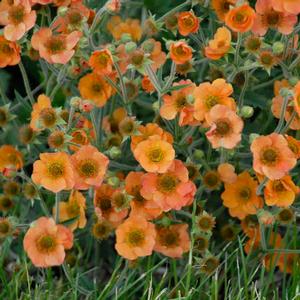Small saucer cupped flowers grow on tall, wiry stems that rise above strawberry like foliage. The bright flowers tend to be red, orange or yellow and occassionally pink or white. These plants are loved for their long bloom time and low maintenance. Bright flowers will be present late spring -summer. With deadheading, they will often continue blooming into the fall.
Geum hybrid 'Totally Tangerine'
Geum

Photo courtesy of Walters Gardens
- Heavy bloomer; providing more flowers at one time than many other geum varieties!
- Apricot-orange flowers
- Compact, mounding habit
- Deep green, fuzzy foliage

Blooms all Season

Border or Bed

Container

Cut Flower/ Foliage

Fast Growing

Garden

Long Blooming
Homeowner Growing and Maintenance Tips:
Plant in sun-part shade. Prefers moist, well drained soil. Easy to grow and adapts well to cold winters. Deadheading promotes reblooming and longer flowering.
Height: 18-30 in
Spread: 18-24 in
Spacing: 18-24 in
Price Level 1: $7.99 ea.~#1
Bloom Color: Orange
Zone: 4-7
Price Level 2: 5 for $35~#1
Additional Characteristics & Attributes:
Attributes:
- Cut Flower/ Foliage
- Blooms all Season
- Edging
- Border or Bed
- Fast Growing
- Low Maintenance
- Garden
- Container
- Long Blooming
- Rock Garden
Critter Resistance:
- Deer Resistant
Exposure:
- Full Sun
- Partial Sun
Habit:
- Mounding
- Upright
Foliage Color:
- Green
Season of Interest (Flowering):
- Summer
- Spring
Attracts Wildlife:
- Attracts Pollinators
- Attracts Hummingbirds
- Attracts Butterflies
Soil Moisture:
- Moist, Well-Drained
Genus Overview: Geum
Common Name: Geum
Small saucer cupped flowers grow on tall, wiry stems that rise above strawberry like foliage. The bright flowers tend to be red, orange or yellow and occassionally pink or white. These plants are loved for their long bloom time and low maintenance. Bright flowers will be present late spring -summer. With deadheading, they will often continue blooming into the fall.


